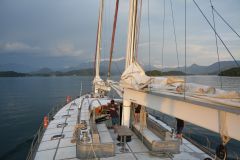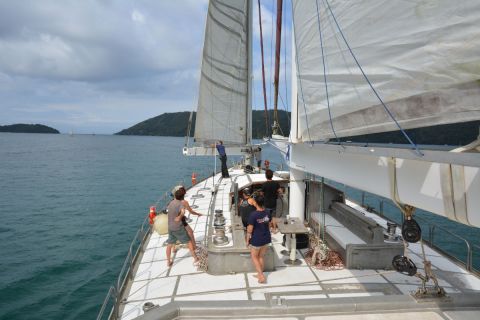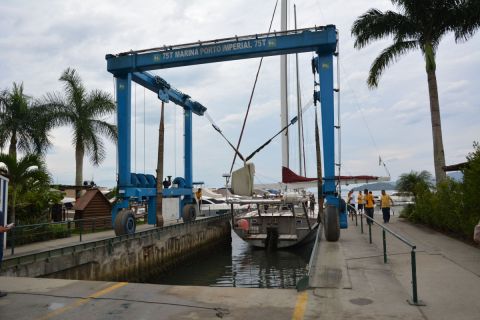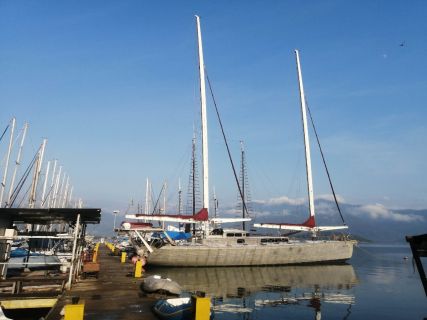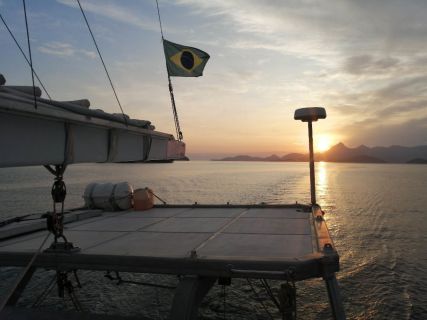A team of seasoned sailors including Mathieu, the captain; Nathalie, second captain; Claire, chief engineer; Matthjis, second engineer; Marie, cook, as well as Stéphane, project coordinator, arrived in Brazil in autumn 2022 to repatriate the vessel to France.
The team meet the schooner at the Marina do Engenho in the village of Paraty, Rio de Janeiro State. Paratii-2 is imposing and inspires confidence with its mass and architecture. Its aluminum hull and two large arched masts are a real eye-catcher. These masts are atypical, not only in shape but also in their function. They are self-supporting balestron masts, whose special feature is that they are rotative. It makes them self-supporting. Thanks to their thickness and their passages through the deck, which give them stability even without stays. This balestron feature enables Paratii-2 to be operated with a reduced crew. This advantage means it can accommodate many scientists during sampling campaigns.
The crew continue to explore the ship. Inside, it's impossible to miss the enormous space allocated to storage in the aft hold. This large open space will host future laboratories. The crew also notes the redundancy of many on-board systems for safety and navigation. The ship has been designed for expeditions to remote polar environments.
Even so, Paratii-2 needs some maintenance before setting sail again. Without delay, the highly qualified crew set about this task, overhauling the vessel by inspecting engines, generators, rigging, electrical system, bilge system, navigation instruments, etc. The ship's overhaul takes two weeks, during which the crew meet the former owner, Amyr Klink.
Amyr is a legend in Brazil. The former explorer and polar enthusiast sailed the Southern Ocean with his family for many years. He circumnavigated Antarctica in solo and wintered in both Antarctica and the Arctic. Amyr Klink owes his reputation to his talents, not only as a writer, but his navigation exploit where he crossed the South Atlantic by rowing from Lüderitz (Namibia) to Salvador (Brazil) in solo.
On October 29th, 2022, the departure was finally underway. The Brazilian authorities gave Paratii-2 the green light to sail to Angra Dos Reis, about 30 nautical miles further north, to finalize the export documents.
The arrival at Angra Dos Reis falls in the midst of an election period. The crew quickly sensed that the situation was tense. Lula, former president and representative of the Workers' Party, and Jair Bolsonaro, current president, and representative of the Liberal Party, face off in a political duel with an uncertain outcome. Roadblocks were popping up all over the city. Days were punctuated by the sound of exploding pyrotechnic devices. A few days later, the crew decided to head further north, towards João Pessoa in the state of Paraiba, to complete the export documents, where the procedure would apparently be quicker.
After a stormy start and a few technical problems, Paratii-2 arrived in João Pessoa seven days later. The crew was welcomed at the Marina Jacaré Village. The atmosphere in the village was relaxed. The crew enjoyed a good meal and a few caipirinhas. The next two weeks were occupied with repairing the various systems that had failed during the last navigation, refueling the ship, obtaining all the necessary authorizations to leave Brazil and changing flags.
In fact, the Swiss flag initially envisaged remains inaccessible, as the ship did not meet all criterias issued by the Swiss Maritime Navigation Office (OSNM). On November 25th, 2022, a provisional yachting flag was finally obtained from the British Maritime Authorities. The ship was then renamed Forel, and the crew completed the export procedures. On the evening of the 25th, Forel set off on her transatlantic voyage, initialy bound for the Azores. Once at sea, the crew felt a certain relief. Convoying, the mission for which the crew had been assembled, could at last begin.
At sea, the routine settled in, in teams of two, the watches were organized. The lack of wind meant that we had to sail with the help of an engine. The crossing of the equator was carried out according to custom - an offering was made to Neptune requesting permission to cross the equator and sail from one hemisphere to the other with good wind and fair seas. Neptune lets Forel pass. However, the desired winds were still not forthcoming. The famous "doldrums", where the trade winds of the northern and southern hemispheres converge, lasts longer than desired. This unstable zone is characterized by a mixture of windless calm zones and violent squalls.
Despite the capricious weather, the crew were treated to a bioluminescence show: the ocean magically lit up blue in the middle of the night. It was probably the effect of a little rain on the plankton clinging to the Sargasso seaweed that produces this luminous reaction. To the delight of the crew, the ship left behind a trail of light over twenty meters long. Forel seems to gravitate above the clouds.
Once out of this zone, Forel continued its course to the Azores. However, the weather decided otherwise. The formation of a subtropical cyclone forced the crew to change course. Normally at this time of year, it's more usual to cross the North Atlantic from east to west, to take advantage of favorable winds. The island of Madeira will be the next stopover. Nineteen days after leaving Brazil, Forel and his crew arrived in Madeira by night, tired but happy to have arrived safely.
The rest was short-lived: just three days after making landfall, Forel left the island of Madeira to take advantage of a favorable weather window to reach Lisbon (Portugal). In Lisbon, the crew took advantage of a break to refuel, rest and enjoy the holiday season. A crew change takes place during this stopover. Baptiste, the second project coordinator and future captain, Julien, Gauthier, and Chloé join Mathieu and Nathalie. Forel sailed along the coasts of Portugal, Spain, and France before arriving in Brest (France) on January 3rd, 2023. The refit will take place in Brittany. Forel will be transformed into a sailing vessel dedicated to polar research before embarking on its first expedition in the summer of 2024.

